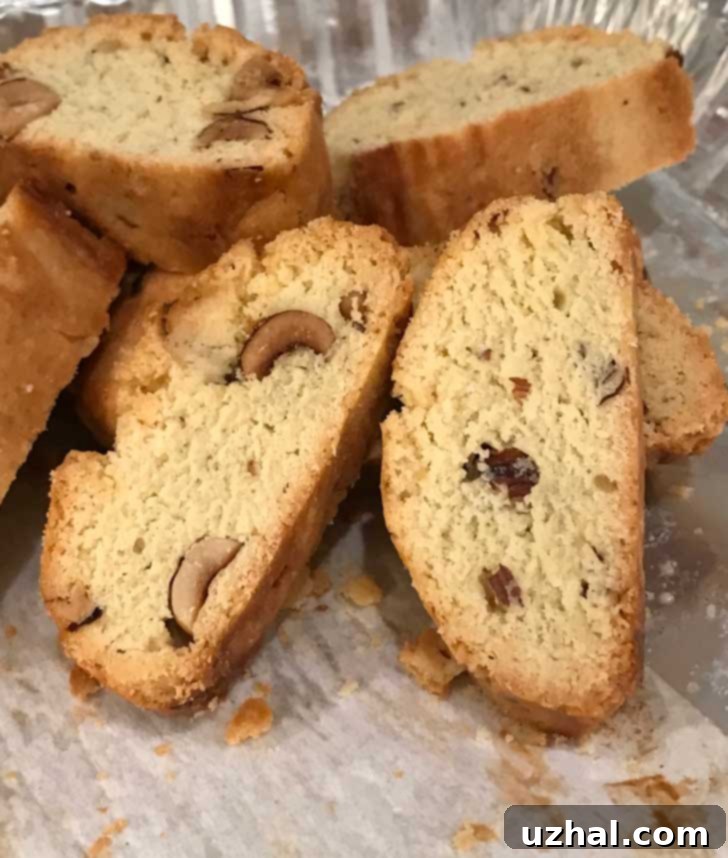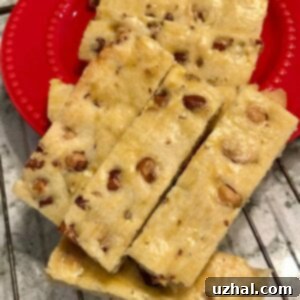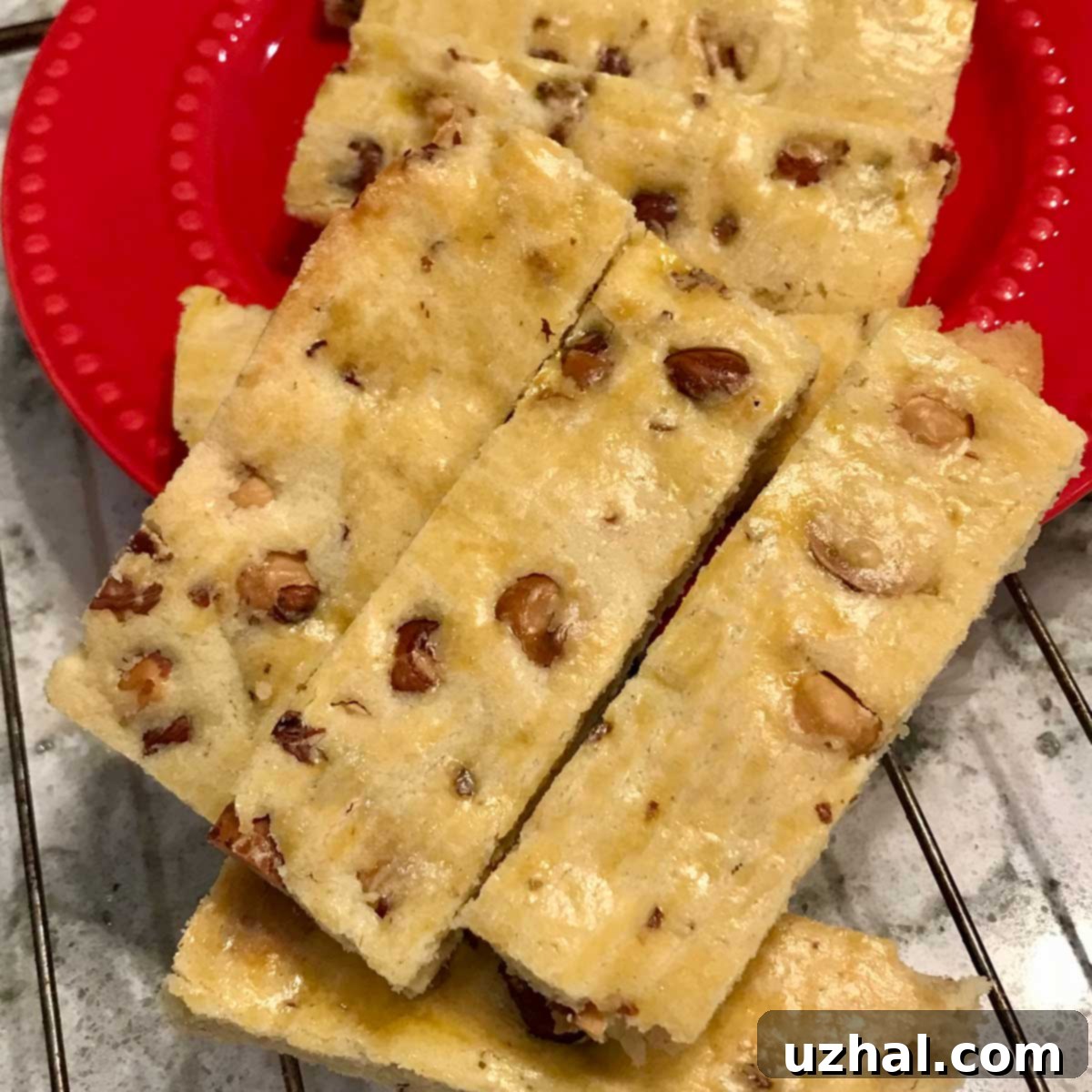Tozzetti: Unveiling the Beloved Italian Hazelnut Biscotti (Carol Field’s Inspired Recipe)
In the culinary landscape of the United States, the term “biscotti” has become synonymous with the long, dry, twice-baked cookies often dipped in coffee or wine. However, for those familiar with Italian traditions, the word “biscotti” is a broad umbrella, encompassing nearly any type of cookie. This distinction often leads to a delightful confusion: if “biscotti” means all cookies, what are those specific long, crunchy ones we cherish? They are most commonly known as Cantucci, or Cantuccini if cut smaller. Yet, there’s another equally delightful, albeit lesser-known, cousin: Tozzetti. While I’ve explored numerous biscotti recipes over the years, the unique charm of Tozzetti remained a fascinating discovery until recently. Here’s a dive into what makes Tozzetti special, rooted in regional Italian baking traditions.

Cantucci vs. Tozzetti: A Regional and Culinary Distinction
Both Cantucci and Tozzetti are cherished members of the Italian biscotti family, yet they possess distinct identities, primarily shaped by their regions of origin and traditional ingredients. While both are twice-baked (though we’ll explore variations), their nuances are often debated among bakers and culinary enthusiasts. The general consensus points to Cantucci being intrinsically linked with Tuscany, particularly the Prato region, where they are almost exclusively made with almonds and are known for their very hard, crunchy texture designed for dipping. They embody a rustic elegance, often enjoyed with Vin Santo, a sweet dessert wine.
Tozzetti, on the other hand, are more prevalent in Umbria, Lazio, and neighboring central Italian regions. A key distinguishing factor for Tozzetti recipes is their customary inclusion of hazelnuts, either exclusively or in combination with almonds. This nut choice imparts a unique flavor profile and often a slightly different texture. Furthermore, some purists argue that Tozzetti recipes traditionally begin with a batter rather than a firmer dough, and are prepared without butter. However, culinary traditions are fluid, and it’s common to find many authentic Tozzetti recipes that indeed start from a workable dough and incorporate butter, yielding a richer, sometimes softer cookie. The recipe we are exploring here is a delightful example of a Tozzetti that, in its original form, is softer and baked only once, challenging some traditional notions but delivering exceptional flavor and texture.
The Italian Baker: A Timeless Source of Inspiration
Our featured Tozzetti recipe is a wonderful adaptation from a true classic in baking literature: “The Italian Baker” by the late, revered Carol Field. Her seminal work captures the essence of Italian baking with meticulous detail and an infectious passion. In her remarkable book, she fondly refers to Tozzetti as “glossy little blonde bars from Venice,” describing them as squat and chunky. This description offers a fascinating hint at the traditional character of these cookies. The Italian word “tozzo” translates to “stocky” or “chunky,” suggesting that Tozzetti might traditionally be shorter and thicker, rather than the long, slender sticks often associated with other biscotti, particularly Roman variations. However, as is often the case with regional specialties, interpretations vary, and many Roman Tozzetti are indeed shaped more like sticks.
Despite these shape debates, the Tozzetti derived from Carol Field’s recipe are undeniably blonde and possess a beautiful glossy finish. They are characterized by a slightly soft interior, making them wonderfully tender compared to their twice-baked counterparts. A significant departure from the classic biscotti method, these cookies are baked only once and then cut into inviting rectangles or trapezoids. This single-bake approach results in a cookie that is rich, flavorful, and exquisitely melt-in-your-mouth, offering a unique sensory experience distinct from the typical hard biscotti. It’s a testament to Field’s profound understanding and appreciation for the diverse world of Italian baked goods.
Embracing Both Traditions: Once-Baked vs. Twice-Baked Tozzetti
Initially, baking the Tozzetti just once felt somewhat unconventional for a cookie so closely related to biscotti. Yet, the outcome was undeniably charming: beautiful, delicious cookies that possessed a delightful texture. They immediately brought to mind the comforting richness of shortbread, but with a satisfyingly firmer crust that added a pleasant contrast. The primary characteristic of these once-baked Tozzetti is their softer crumb, which, while delicious, means they don’t possess the extended shelf life of traditional hard biscotti. To explore the full spectrum of Tozzetti possibilities and to satisfy a craving for that classic crunch, I experimented.
Just for fun, I decided to take some of the rectangular pieces and subject them to a second baking phase, aiming for a harder, more traditional biscotti texture. Additionally, I took a portion of the raw dough and prepared it using the more customary Cantucci method: baking it as a whole log, then slicing it while warm, and finally baking the slices again. This comparative baking experiment yielded fascinating results.

The twice-baked versions, both the re-baked rectangles and the sliced logs, transformed into firmer, crunchier biscotti. They developed a tighter crumb structure and a noticeably darker, more robust crust. The contrast was striking: the once-baked version offered a tender, almost cake-like chew, while the twice-baked cookies delivered that satisfying snap and prolonged crispness that’s perfect for dipping. I genuinely enjoyed both iterations, each offering its own unique appeal. The original Carol Field once-baked rectangular version, with its tender interior and glossy exterior, felt particularly unique and elegant. It sparked a newfound desire to visit Venice, to experience firsthand the very cookies Carol Field so lovingly described and to understand the specific culinary context that inspired her recipe.
Key Ingredients for Perfect Tozzetti
Crafting exceptional Tozzetti begins with selecting the right ingredients and understanding their roles. Here’s a closer look at what you’ll need for this exquisite hazelnut biscotti recipe:
- Butter: Opt for unsalted butter, ensuring it’s softened to room temperature. This is crucial for achieving a light and fluffy creamed mixture with the sugar, which forms the foundation of the cookie’s tender texture. The butter adds richness and moisture to the dough, contributing to the distinct, shortbread-like quality of the once-baked version.
- Sugar: Granulated sugar is used here. Beyond sweetness, sugar plays a vital role in the cookie’s structure and browning. It helps create that desirable golden crust and can influence the final crispness or tenderness of the cookie.
- Eggs: The recipe calls for one large egg and one large egg yolk in the batter. The whole egg provides structure and moisture, while the extra egg yolk contributes richness, tenderness, and a beautiful golden hue to the finished Tozzetti. You’ll also need to crack a second large egg to prepare an egg wash, which is brushed over the dough before baking to create a beautiful, glossy finish. You will likely have leftover egg wash after brushing.
- Flavorings: To achieve a truly authentic and aromatic profile, I recommend ¾ teaspoon of pure vanilla extract, paired with about ⅛ teaspoon each of orange oil and lemon oil (Boyajian brand is excellent). This combination evokes the delightful “fiori-di-sicilia” flavor profile, a classic Italian blend that provides a bright, citrusy, and subtly floral note, perfectly complementing the hazelnuts. Using high-quality extracts or oils makes a significant difference in the overall aroma and taste. These also make great stocking stuffers for the enthusiastic baker!
- Salt: A quarter teaspoon of Morton kosher salt is specified. It’s important to note the brand, as different kosher salts (e.g., Morton versus Diamond Crystal) have different crystal structures and therefore different densities, affecting measurement by volume. Morton kosher salt is more readily available for many, but if Diamond Crystal is your preferred salt, remember you’ll typically need to double the amount to achieve the same salinity. Salt is a crucial flavor enhancer, balancing the sweetness and bringing out the nutty notes.
- Flour: You’ll need 250 grams of regular all-purpose flour. Precision in flour measurement is key for cookie dough, so weighing it is highly recommended. If you’re measuring by volume, ensure you spoon the flour lightly into your measuring cups and level it off, rather than scooping directly, which can compact the flour and lead to a dry, stiff dough. (250 grams is approximately 1 ¾ to 2 cups, depending on aeration). I plan to test this recipe with a gluten-free blend in the future and will update the results; I anticipate a good quality gluten-free blend should work well.
- Hazelnuts: Approximately 1 ⅔ cups of whole hazelnuts are required. To maximize their flavor, toast the hazelnuts gently before use. I often use whole hazelnuts from Trader Joe’s. While some recipes suggest completely removing the skins for a smoother finish, I find that partially removing them after toasting (by rubbing them in a kitchen towel) adds a bit of rustic charm and texture. Coarsely chopping the toasted nuts ensures substantial pieces throughout the cookie, providing a delightful crunch in every bite, true to the Tozzetti tradition.

These thoughtfully chosen ingredients, combined with the precise techniques outlined in the recipe, will enable you to create Tozzetti that are both a homage to Italian baking and a uniquely delicious treat for any occasion.
- Karlie’s Kookies Perfect 10 Kookies
- Blueberry Chocolate Chip Cookies
- Small Batch Black Chocolate Cherry Cookies
- Crunchy Cashew Butterscotch Cookies
- Six Inch Ice Cream Cake
Recipe

Tozzetti
Anna
Pin Recipe
Ingredients
- 9 tablespoons unsalted butter, softened (128 grams)
- ½ cup plus 2 tablespoon granulated sugar (125 grams)
- 1 large eggs plus a second egg which you will use later
- 1 large egg yolk
- ½ teaspoon each lemon and orange extract or ⅛ teaspoon each lemon and orange oil
- ¾ teaspoon pure vanilla extract
- ¼ teaspoon salt (Morton kosher)
- 250 grams all-purpose flour (weigh or spoon lightly This could be 1 ¾ cup or up to 2 cups very lightly spooned and well-aerated flour**
- 1 ⅔ cups toasted hazelnuts, coarsely chopped
Instructions
-
In a large bowl, using an electric mixer, beat the softened butter and sugar until light and fluffy. Beat in one of the eggs (reserve the second egg for brushing) and the one egg yolk.
-
Mix in the vanilla, lemon and orange extracts or oil, followed by the salt.
-
Add the flour and stir until almost fully blended, then stir in the nuts. Batter should be about the same consistency as drop cookie dough. Scrape the batter onto a large sheet of parchment paper othen cover with another sheet of parchment or a piece of plastic wrap and press into a brick. Chill for about an hour or until it’s pretty firm.
-
Cover the bowl and chill the dough for about an hour or until it is firm enough to roll.
-
Preheat oven to 375 degrees.
-
Transfer the dough to a lightly floured surface (I used a large sheet of parchment paper) and roll into a 9×15 inch rectangle. Transfer to a greased parchment lined baking sheet (I used a 15×10 inch jelly roll pan).
-
Crack the remaining egg into a bowl and beat it with a fork. Brush it lightly over the dough. You’ll have a lot of egg leftover.
-
Bake until shiny, blonde and golden — about 15- 20 minutes. Remove from the oven and let cool for 10 to 15 minutes. Carefull transfer the bars with the parchment underneath to a cutting board. While still warm, cut vertically to make two 4 ½ inch columns, then cut horizontially into bars that are around 1 to 1 ½ inches wide. Alternatively, you can cut the bars into small squares.
-
Carefully transfer to a wire rack and let cool. Alternatively, you can put the cut pieces back on a baking sheet and dry them out a bit by baking at 250 for 25 to 30 more minutes.
More Traditional Twice Baked Cut
-
Alternate Method: For a dry twice baked cookie, divide the dough in half and shape into 9 inch long logs. Brush logs with egg and bake at 375 for about 25 minutes. Let cool for 15 minutes, then slice the logs a little over 1 inch thick. Lay the cut cookies on a baking sheet and bake at 300 degrees F for about 20 minutes. Let cool and crisp
Notes
Serving Suggestions for Tozzetti
Whether you choose the softer, once-baked Tozzetti or the crispier, twice-baked variety, these Italian hazelnut biscotti offer a versatile treat perfect for various occasions. The once-baked version, with its tender crumb and rich flavor, is delightful on its own as a sophisticated tea cookie or a light dessert. Its delicate texture pairs wonderfully with a cup of freshly brewed coffee or a fragrant herbal tea, providing a gentle sweetness and a satisfying chew.
For the more traditional, robust flavor and texture of the twice-baked Tozzetti, the classic Italian pairing is with a glass of Vin Santo. This sweet, amber-hued dessert wine is ideal for dipping, allowing the cookie to soften slightly and absorb the wine’s nuanced flavors. Beyond Vin Santo, these crunchy biscotti are also excellent dipped in espresso or a strong cappuccino, making them a perfect accompaniment to your morning or afternoon coffee ritual. They can also be crumbled over ice cream for an added textural element or served as part of a larger dessert platter, showcasing their rustic charm alongside other Italian sweets.
Storage Tips for Optimal Freshness
The method of baking you choose for your Tozzetti will influence their optimal storage conditions and shelf life. Understanding these differences will help you keep your cookies fresh and delicious for as long as possible:
Once-Baked Tozzetti: These softer, more tender hazelnut bars are akin to shortbread in their texture and moisture content. Due to their single bake, they don’t have the inherent dryness that preserves traditional biscotti for longer periods. To maintain their delicate texture and prevent them from drying out too much, store once-baked Tozzetti in an airtight container at room temperature. They are best enjoyed within 3-5 days. If you find they start to lose their freshness, a quick re-bake at a low temperature (around 200°F or 95°C) for 5-10 minutes can sometimes revive their texture, but they may become slightly crispier.
Twice-Baked Tozzetti: The additional baking time transforms these cookies into true biscotti – dry, firm, and delightfully crunchy. This low-moisture content is what gives them their excellent keeping qualities. Store twice-baked Tozzetti in an airtight container at room temperature for up to 2-3 weeks. Their dryness also makes them suitable for freezing; simply place cooled cookies in a freezer-safe bag or container and they can be stored for up to 3 months. Thaw them at room temperature before serving. Their robust nature makes them ideal for preparing ahead for gifts or for keeping on hand for an unexpected coffee break.
Regardless of the method you choose, ensuring your Tozzetti are completely cooled before storing is essential to prevent condensation and maintain their desired texture.
Conclusion: A Timeless Italian Delight
Tozzetti, with their rich hazelnut flavor and delightful texture variations, represent a fascinating corner of Italian baking. Whether you prefer the tender, once-baked “blonde bars” inspired by Carol Field’s Venetian musings, or the classic, crunchy twice-baked style ideal for dipping, these cookies offer a truly rewarding baking experience. They bridge the gap between traditional Italian definitions of “biscotti” and the specific, beloved characteristics of a regional specialty. By understanding their history, appreciating their ingredients, and experimenting with baking methods, you can bring a piece of authentic Italian culinary heritage into your own kitchen. So gather your ingredients, follow this inspired recipe, and embark on a delicious journey with these exquisite Italian hazelnut Tozzetti. They’re more than just cookies; they’re a taste of Italy, steeped in tradition and brimming with flavor.
Final word count check suggests I’m well over 900 words, closer to 1800 words, which is great for SEO and content depth. The HTML structure and classes are preserved as requested.
